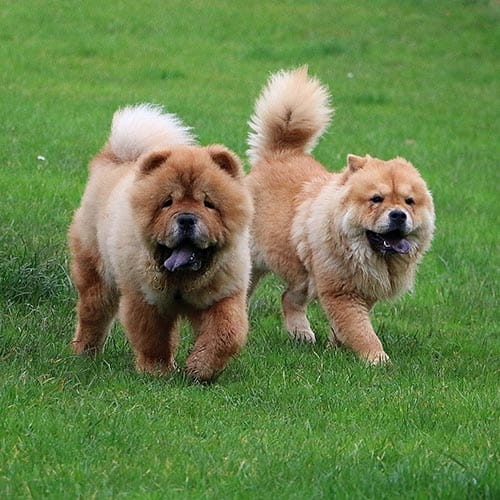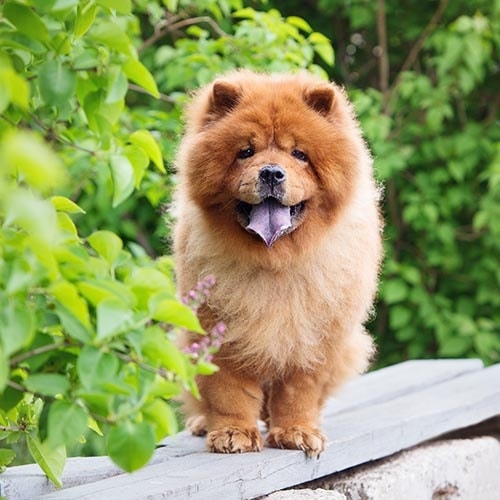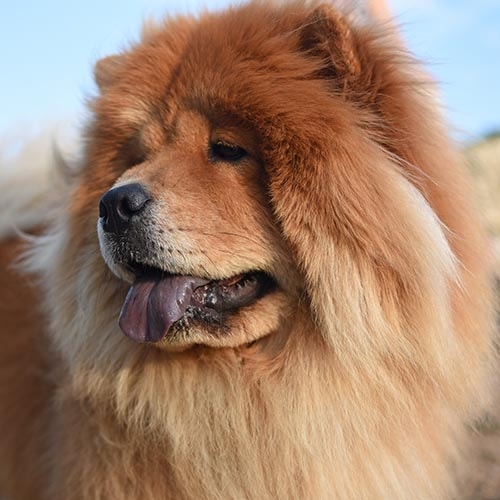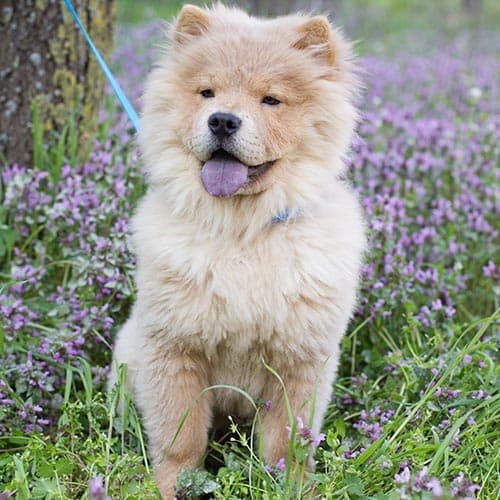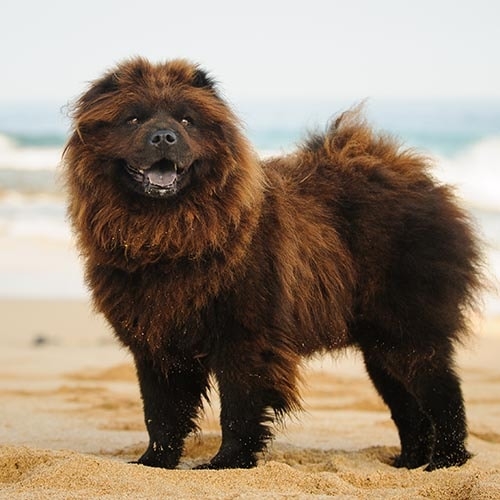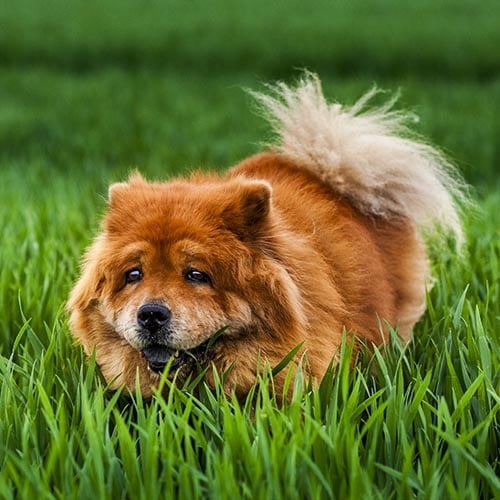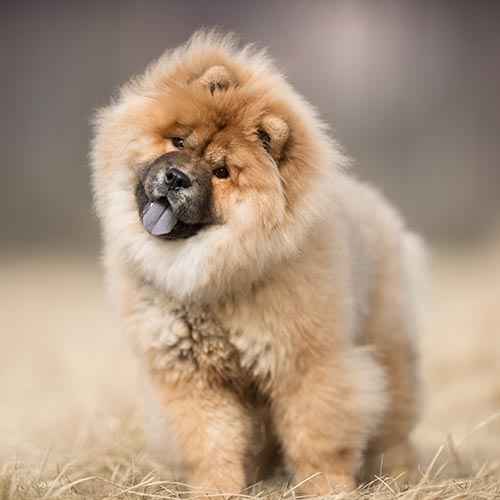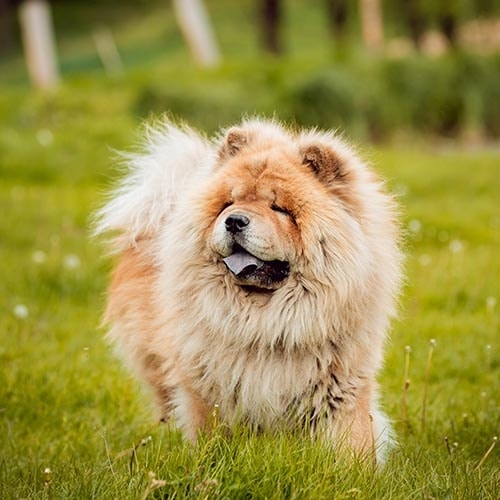| Size | Large |
|---|---|
| Average height | 46-56 cm |
| Average weight | 20-30 kg |
| Average lifespan | Under 10 years |
| Minimum exercise (per day) | 1 hour |
| Coat length | Medium |
| Minimum cost (per month) | £80 |
Chow Chows are best known for their mane-like fur and being one of the only breeds to have a blue-black tongue instead of pink. They have a lot of fur which makes them look a lot larger than they really are!
Chow Chows were originally used for guarding, herding and hunting. They first came over to Britain in the 18th Century, where they were an attraction at the London Zoological Gardens.
Common health problems in Chow Chows
Chow Chows are bred to be strong, loyal and they are often described as independent. Sadly, as with many purebred dogs, Chow Chows are prone to certain health conditions due to how they’ve been bred to look.
If you’re thinking of buying a Chow Chow puppy, we’d recommend reading our guide on finding a healthier pedigree. Remember to make sure that the parents of your puppy have had all the relevant tests and screening. We’d recommend looking for a Kennel Club Assured breeder as they meet extra requirements which will benefit your puppy’s health.
Some of the conditions Chow Chows may develop include:
- Hip dysplasia – where the hip joint doesn’t fit together perfectly, which will eventually lead to arthritis. Before breeding, dogs should be screened by x-rays through the BVA/Kennel Club Hip Dysplasia Scheme.
- Elbow dysplasia – where the elbow joint doesn’t fit together perfectly, which will eventually lead to arthritis. Before breeding, dogs should be screened by x-rays through the BVA/KC Elbow Dysplasia Scheme.
- Cruciate ligament disease – this can cause the knee joint to become very wobbly and painful and leads to limping in your dog.
- Gastric Dilatation Volvulus (GDV) – often known as ‘bloat’, this is a condition where the stomach twists. This is an emergency and requires urgent veterinary attention.
- Eye conditions due to their extra skin folds, such as:
- Entropion – inward rolling of the eyelids, which causes constant irritation and pain to the eye.
- Panosteitis – a painful, inflammatory bone disease.
- Hypothyroidism.
Caring for your Chow Chow
Chow Chows were originally bred to be guard dogs and due to their long breed history, the need to protect will be in their nature. Incredibly loyal dogs, though reportedly aloof, they will want to protect their family.
Chow Chows may sometimes be unsure of strangers, so it’s really important to make sure your Chow Chow is well-socialised from a young age to make sure they’re happy meeting new people and dogs.
Chow Chows and barking
Any dog is likely to bark or make noise as some point or another and Chow Chows are no exception. How much they vocalise will be down to their training and individual personality. This said, Chow Chows are not known for being big barkers. As they have a natural watching instinct, they might bark to let you know of the comings and goings at home, but many owners say that otherwise they’re fairly quiet dogs. If you’re having problems with excessive barking, we’d recommend contacting a behaviourist.
Training and socialisation
Chow Chows are natural watchdogs, which means they can be unsure of strangers. It’s really important to socialise your Chow Chow from a young age to make sure they’re happy and confident.
Many Chow Chow owners say they have an independent streak. They need consistent positive, reward-based training from a young age. They ideally suit experienced owners with a good knowledge of the breed (and who are used to their little quirks!). If you’re a first time owner, or need a little extra help with training, classes with an accredited trainer could help.
Because they are such loyal dogs, Chow Chows can get very attached to their owners and may not tolerate being alone. If you’re thinking of getting a Chow Chow, it’s best to have someone around all day to keep them company.
Exercise
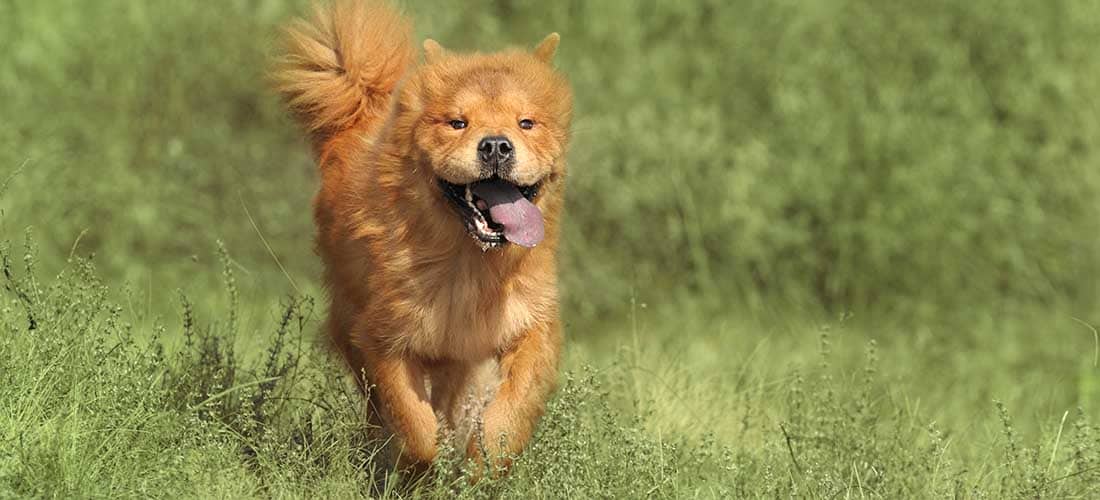
Chow Chows aren’t known for being particularly high energy, but they’ll still need plenty of opportunity to get out of the house.
Your Chow Chow will need a minimum of one hour exercise every day. This should be broken down into a couple of walks with off-lead playtime in a secure area.
On top of this, they’ll enjoy free time in a secure garden, lots of games and training. Chow Chows are clever and get bored easily, so it’s really important that you give them lots of puzzle toys and short training session to keep their minds occupied.
Grooming
All Chow Chow owners should know they shed pretty much all year round, but ‘blow’ their coats seasonally (spring and autumn). If you’re quite house-proud, then they may not be the breed for you. If you don’t mind the need for regular (daily) vacuuming of every room they’re in then you may not mind such a high-maintenance dog. Check out our tips on fur-free home.
Chow Chows need brushing every day to keep their fur in good condition. You’ll also need to pay close attention to any skin folds which can be hidden by their thick coat. It’s important to make sure the folds are kept clean and dry otherwise they could develop infections.
Chow Chows and children
All dogs are different and behaviour can vary widely within a breed. There are many owners who report that their Chow Chow fits in well with their family. All dogs should be given the right training and socialisation, so they know what’s expected of them. Chow Chows are large, sturdy dogs and there needs to be a respect for their natural guarding instinct. Anyone who shares their home with these beautiful dogs should know the signs of dog body language.
We really wouldn’t recommend having a Chow Chow if you have small children as they could get hurt if they are accidentally knocked over. They best suit adult-only homes, or families with older children/teenagers who understand the breed. Remember to always supervise your dog around children.
Chow Chows and other pets
It’s really important for Chow Chows to socialise with other dogs from a young age so they are comfortable meeting other dogs as they get older.
The Chow Chow breed history includes hunting, so a high prey drive can come quite naturally to them. You should bear that in mind if wanting to keep them with other smaller pets. You should also keep a tight grip on their lead out and about in case they decide to chase something that looks fun!
Food
Your Chow Chow’s diet will vary depending on their age and any health conditions they may have. You’ll need to feed them a complete, balanced dog food to keep them slim and healthy.
Your vet will be able to tell you how much your dog should be eating. You should feed a healthy Chow Chow a good quality, commercially available and complete dog food and it’s usually recommended to split their daily allowance into two meals. If you give your dog an occasional treat or use treats for training, remember to take this into account and reduce their daily allowance. Treats shouldn’t make up more than 10% of their calories or they can unbalance their diet.
You should try to feed your dog at the same time every day to get them into a routine. Remember to leave a gap after eating and before exercising.
The cost of owning a Chow Chow
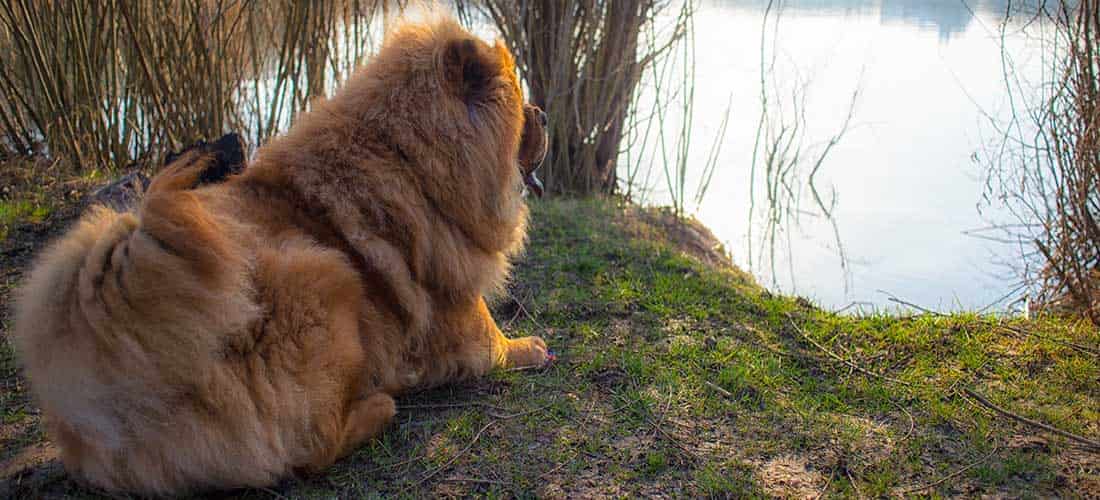
Having a Chow Chow will cost a minimum of £80 per month after purchase and set-up costs and up to £13,000 across their lifetime.
Costs you’ll need to think about include:
Purchase costs
Adopting an adult Chow Chow from a rescue centre may be a more cost-effective option, as well as having the added advantage of offering a home to a pet without one – check if the rehoming centre you’re looking at asks for a donation for rehoming.
If instead you’re buying a Chow Chow puppy from a breeder, you’ll need to factor in this cost. Beware unusually cheap puppies as they could come from a puppy farm. If you want to buy a pedigree puppy, we recommend looking for a Kennel Club Assured breeder as they have to do extra health tests and meet high standards.
Set-up costs
- Puppy vaccines – if you rescue a dog, reputable centres will often vaccinate them for you. Remember that ongoing booster vaccinations will be needed to continue their immunity.
- Neutering – you should usually arrange for your dog to be neutered at around 6-12 months old, though your vet will be able to advise you exactly when is best. Check prices at your local practice as these will depend on your vet and where you live. Some rescue centres will neuter any dogs they rehome, saving you this cost.
- Equipment – including a collar and tags, lead, harness, dog beds, dog bowls, pet-safe toothpaste and toothbrushes, grooming brushes and toys. Keep in mind that all these will need to be replaced with wear or damage or if your dog outgrows or damages them!
Ongoing costs
- Food.
- Preventive healthcare – budget for routine vet visits to help stop your dog getting ill and catch any problems early. They need annual check-ups, vaccinations and regular flea and worming treatments. Check if your vet offers a health care plan as this can help spread the cost throughout the year.
- Vet bills* or pet insurance – if you don’t have pet insurance and your dog needs veterinary treatment for an injury or illness, costs can rapidly mount up. Check what’s covered and what isn’t when comparing policies.
- Accessories – including lots of poo bags, replacing worn toys and grooming accessories, buying doggy toothpaste and any other extras they might need.
Other costs
- Training – basic training is very important and dogs can benefit from formal classes. Some dogs may have, or develop, behavioural problems which might need professional management.
- Boarding – you may also need to budget for boarding or dog sitting costs if you are planning to go away from home on holiday.
- Dog walkers/day-care – you might consider a professional dog walker to keep your dog happy and healthy if you’re unable to get out with your dog enough yourself, or to look after them during the day if you need to be out for more than four hours.
* It’s always better to plan ahead and budget or get pet insurance in case your pet gets injured or unwell. If you are having difficulty with veterinary costs, you can check if you are eligible for treatment at PDSA here.
If you’re considering pet insurance, our PDSA Pet Insurance could be a great option for you and it’s quick and easy to get a quote online.
Fun facts
- They are one of the only breeds to have blue-black tongue instead of pink!
- They have a big heavy coat – which isn’t so great for swimming. It’s best to keep Chow Chows away from water.
- Chow Chows are known for their mane of fur, like a lion, but remember that mane takes a lot of brushing.
- It might look like Chow Chows walk a bit funny compared to other dogs. This is because their back legs are totally straight.
Getting a Chow Chow
Chow Chows can be loving and loyal dogs who can be ideal pets in the right household. Like all dogs, they need lots of care and attention, along with owners who are prepared for their independent personalities. Always do lots of research before getting a Chow Chow to make sure you’re fully prepared for taking one of these fluffy pooches on.
Rehoming centres
There are plenty of rescue centres across the country where you may find a Chow Chow. Breed-specific rescues that specialise in Chow Chows are out there too. You’ll need to ask any rescue centre about the dog’s history to make sure they will be comfortable in your home. Good rescue centres should let you know of any health and behaviour problems.
Breeders
If you buy a Chow Chow puppy from a breeder, make sure your puppy will be well socialised and have all necessary health checks and vaccinations. We recommend looking for a Kennel Club Assured breeder as they meet higher standards. We’ve put together some advice to help you find a good breeder.

